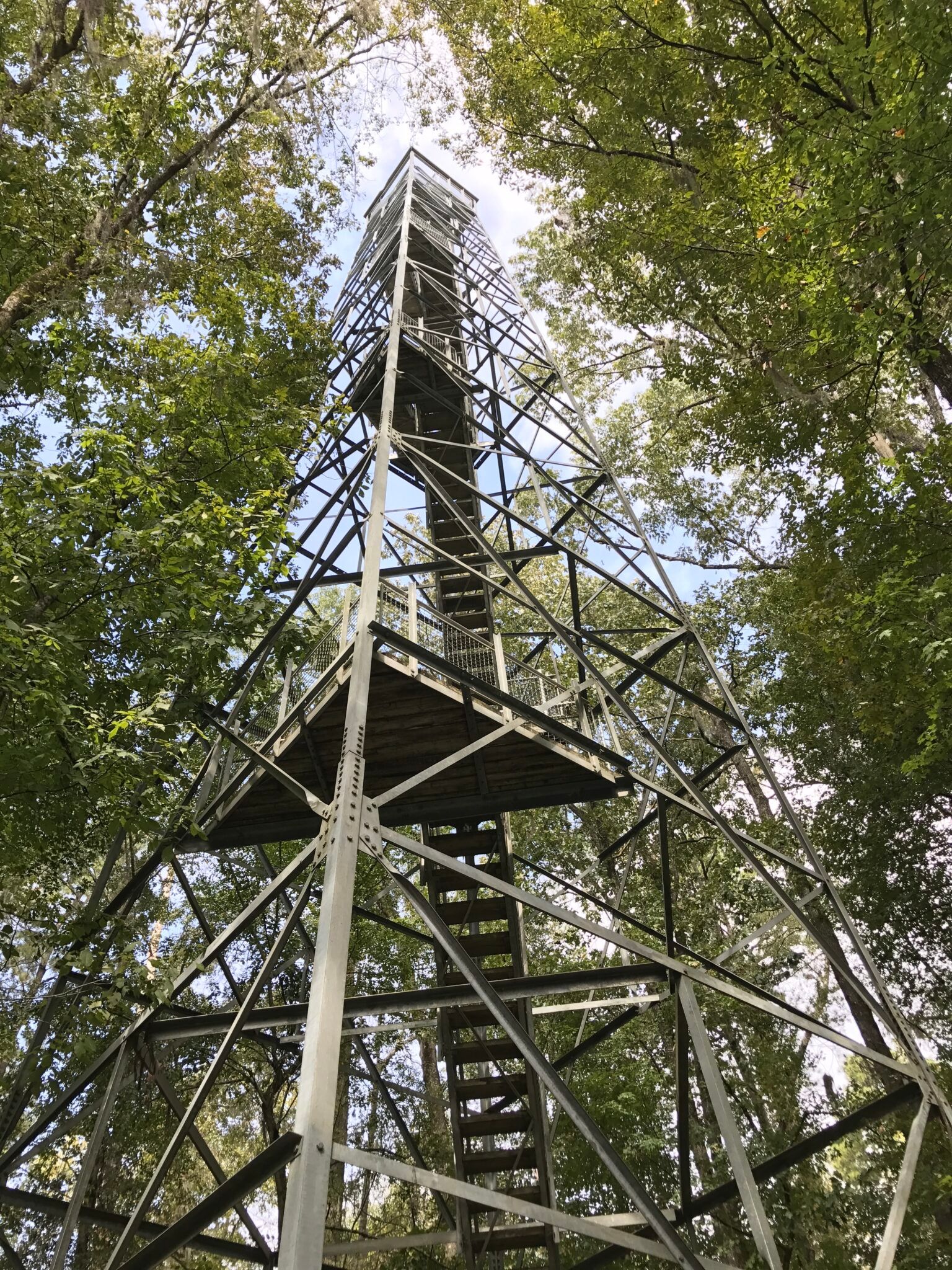




BIRDING TOWER IN WINTER. PHOTO CREDIT: DANIEL FULLER
It is truly two separate worlds. In the summer months, I met birders with massive telephoto lenses visiting from as near as Birmingham and as far as Chicago. But on this winter morning, I’m alone out here.
You start on the boardwalk that runs along the edge of the water. Perry Lakes Park contains four oxbow lakes, each formed when the Cahaba River changed course 150 years ago. Walking through the Park’s mature hardwood forests, you face the many tupelos and bald cypresses with their horizontal roots just below the surface and protruding upward from the glassy black water. Despite the Birding Tower’s imposing presence, it can be easy to miss at first through the camouflage of the bluish-gray streamers of Spanish moss floating off the leafless trees.
Once you reach the foot of the Perry Lakes Park Birding Tower, though, man, it’s stunning. The open-air stairway climbs to the clouds. Along with a cedar picnic pavilion, modern-designed bathrooms, and a triangular-shaped covered footbridge, the tower is part of a series of projects in the Park completed by 5th-year design-build students from the Rural Studio program through Auburn University. Long known for using reclaimed and unconventional materials in innovative ways, a team of four students purchased a decommissioned fire tower from the state Forestry Commission for $10. Each student had to be trained and certified in tower construction before they began dismantling the 18,000 pounds of steel. Using ropes, pulleys, and grit, they spent 15 days deconstructing and documenting the pieces, followed by 45 days putting them back together with new handrails and viewing platforms.


Adrenaline leads the way as you start up the stairwell, the equivalent of a 10-story building; things change quite a bit during the journey to the top. As you climb, the stairwell grows narrower and steeper as you reach each new landing. Zig-zagging upwards, the staircase’s risers start to meet at impossible angles. 2/3rds of the way up, a brisk wind starts rushing around you. A heavy whoosh is the only thing you can hear. The tower is beginning to sway, or it may be a wobble in your knees. At the peak, the students replaced the cab with an open viewing platform with a breathtaking 360-degree vista.
In the summer, this is almost sport, the memory of collecting the region’s nearly two-hundred birds. Keep a keen eye out for Orange-crowned Warblers, Yellow-rumped Myrtles, white ibis, merlins, Wilson’s snipes, sandpipers, and Yellow-billed cuckoos. High above the trees with a pair of binoculars, you can look back towards the Park’s entrance for a long-established Bald Eagles nest in giant loblolly pine.
But today, in the wintertime, the birds can only be heard. The rush of the climb subsides, and a sense of motionless tranquility sets in. Your view on the far horizon sweeps passed the trees and onto the low, gently rolling hills of western Alabama farmland, then further to the jagged ripples of faraway hills. I’ve been up here an hour and have seen no airplanes pass, despite their crisscrossing chemtrails being the only blemishes to an otherwise flawless, impossibly blue sky. Perhaps I’m misremembering, but I feel there is some cliché saying about “up here, the world sits still.” That would be wrong. The cheerful birdsong that seems to grow louder in the wind is proof of that. It would be more accurate to say that up here, “I sit still.” That Rural Studio has provided this place, this combination of art, architecture, and civic project demonstrates the sheer beauty of Alabama’s Black Belt in a way that can never be forgotten.

Before moving to the South, I was infatuated with the work Samuel Mockbee and his colleague D.K. Ruth started with Rural Studio and how Andrew Freear has continued that mission to help develop “citizen architects.” To instill a moral code, the work beside the work, the intertwining of work and public service. A passage from Mockbee’s essay in Architectural Design Everyday and Architecture in 1998 resonates deeply: Love your neighbor as yourself. This is the most important thing because nothing else matters. In doing so, an architect will act on a foundation of decency which can be built upon. Go above and beyond the call of a ‘smoothly functioning conscience’; help those who aren’t likely to help you in return and do so even if nobody is watching!”
I lived in Atlanta for three weeks before making my first trip to Newburn to get a map of Rural Studio’s over 200 projects. This map has long guided me to a place that once seemed so foreign. This map has helped me become a better neighbor.




Daniel Fuller is a writer and curator based in Atlanta, Georgia. Since 2004, he has curated over 175 exhibitions at sites such as museums, art fairs, ice fishing shacks, a swap meet, the JumboTron of a minor-league hockey stadium, public access television, the caboose of the Chattanooga Choo Choo, and on cable television’s most popular show, VH1’s Love & Hip Hop. Previous institutional positions include curator at Atlanta Contemporary and director at The Institute of Contemporary Art at Maine College of Art, Portland, Maine. His writing has appeared in many magazines, including ArtForum, Art in America, ARTnews, Afterall, Art Asia Pacific, Art Papers, Burnaway, Crease, The Brooklyn Rail, Frieze, KALEIDOSCOPE, Upstate Diary, The Wine Zine, and numerous artist catalogues. He recently wrote an 032c cover story on the rapper Gucci Mane. Fuller currently teaches at Emory University.